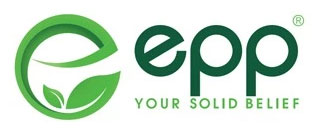FIBC bags manufacturing process is being concerned by many businesses to find the most accurate bulk bags for their applications. FIBC bulk bags are chosen to pack and protect goods from spilling out during transportation. Therefore, they are considered effective packaging solutions for many industries. The outer surface of FIBCs is hard, not as flexible as PE, and has high mechanical strength. In this article, EPP wants to share with readers about the production process of this quality bag.
Standard FIBC bags manufacturing process
To ensure their quality and function, FIBC bags are usually manufactured according to a certain process. The production lines of FIBC bags are carried out in the following 7 steps:

FIBC bags manufacturing process is being concerned by many businesses to find the most accurate bulk bags for their applications.
Step 1: Extrusion of raw materials
This is the first and extremely important step in the production of FIBC big bags. First, a mixture of virgin polypropylene resins, UV inhibitors, calcium carbonate, and color pigments is put inside an extrusion plant. Next, the plastic tapes are created and passed through a cold water bath. After that, the machine will slit the plastic film into 2 to 3 mm yarns. In the end, these PP yarns are wound on bobbins of the desired size by the manufacturer. This first stage can determine the tensile strength of PP yarn.
Step 2: Weaving fabric and loops of FIBC bulk bags
After the extrusion, PP yarns are loaded on either a circular loom of 6 or 12 shuttles or a flat (Sulzer) loom depending on the required size and specification. The loom will weave them into tubular or flat PP fabric. At the end of the weaving process, all PP fabrics will be wound in rolls. They are used to make the FIBC’s body and some other parts such as the filling spout or discharge spout.
In addition, in this process, the manufacturers also need to weave the loops in FIBC belt weaving machines. Loops are also made from PP yarn, but with completely different density and specifications compared to the body fabric.
Step 3: Lamination
The manufacturers will laminate the bulk bags according to the customer's request. In this process, the PP fabric will be bonded with a semi-clear PP film with a thickness of about 30 microns in a laminating machine to increase moisture resistance. After that, PP fabric rolls will be moved to the automatic cutting step.
Step 4: Cutting
After completing the above steps, PP fabric rolls will be passed through the folding system. Then it will be cut into some parts such as the body, bottom, top, filling and discharge spout of a bulk bag. The PP woven loops will also be put into the cutter in this step. Most factories now use automatic thermal cutting machines to ensure that the cut fabric is not torn, reducing the aesthetic value of the bag as well as its durability. Each part will have different types of the special cutting machines.
Step 5: Printing
After cutting, the body fabric will be transferred to a modern flexographic printing process. Depending on customers’ requirements, jumbo bags can be printed on 1 side or 2 sides with different colors.

After cutting, the body fabric will be transferred to a modern flexographic printing process
With modern flexographic printing technology, the logos and information of inside materials are printed sharp and clear on the bags.
Step 6: Industrial sewing
At the end of the printing process, all parts of bulk jumbo bags will be moved to the sewing workshop area. Workers will be assigned to undertake each stage to produce finished bulk bags. Besides some important parts including the bottom, top, loop and body, manufacturer's label, tie for the filling and discharge spout as well as a document pocket are also attached to the bag with the size depending on the customer's request.
Step 7: Inspection
After being sewn, big bags will be immediately transferred to the quality control area. This is also an extremely important step in determining whether your FIBCs have stable quality or not. Each bag will be checked by QC staff from the seam to the folded edges and dimensions. If any errors are detected, the bag will be completely discarded. All quality finished FIBC bags will be taken through the folding and baling area to wait for warehousing or shipping.
Purchasing quality FIBC bags at low price from EPP Vietnam
Currently, FIBC bags are applied to packaging, storing, and transporting goods in most industries. Many suppliers also provide Jumbo bags with many different designs and qualities. Therefore, businesses need to choose a supplier that provides quality FIBC bags at an affordable price to optimize the cost.
EPP is proud to be one of the most reputable and quality suppliers of FIBC bags with many years of experience in the field of packaging production. By choosing our products, you will receive many attractive incentives.

Currently, FIBC bags are applied to packaging, storing, and transporting goods in most industries. Many suppliers also provide Jumbo bags with many different designs and qualities
- Products have good quality, ensuring the correct production process and standards in the packaging industry.
- Quality materials have no harmful substances to ensure the users’ health.
- Modern equipment and machinery are applied to produce bulk bags in accordance with customers' designs.
- The most competitive price in the market is consistent with product quality as required by customers.
Readers have just learned about the FIBC bag manufacturing process and the supplier of the best quality products. If you want to purchase quality products at affordable prices, please visit https://epp.vn to choose the suitable types and contact hotline 84 986 002 888 for the most detailed advice.
🌐Website:https://epp.vn// https://eppvietnam.trustpass.alibaba.com/
📲Ms. Jennifer: +84 962 055 998 - sales02@epp.vn
📲Ms. Charlie: +84 986 002 888 - sales@epp.vn



